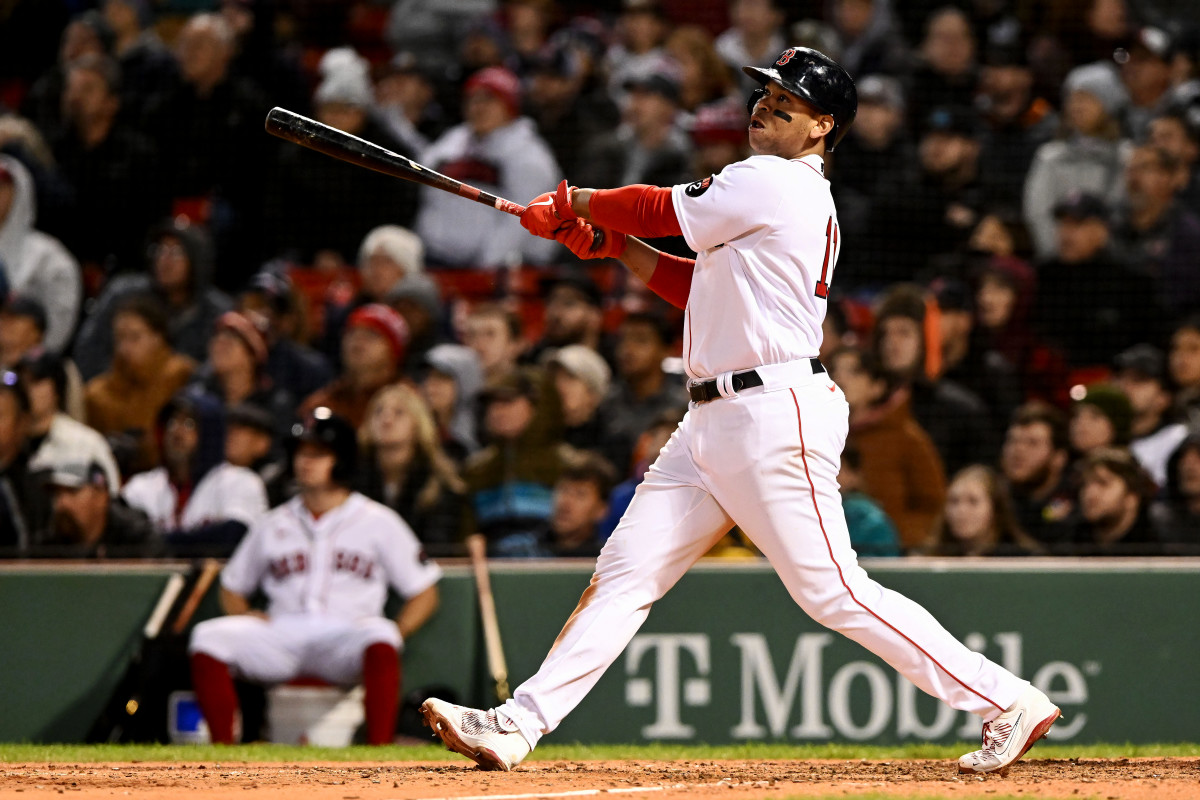Extending Rafael Devers Gives the Aimless Red Sox a Direction

In a vacuum, Rafael Devers’s 11-year, $331-million extension with the Red Sox is a smart move to retain one of the brightest third basemen in the game.
But in context? It feels like something bigger. The Devers extension seems almost essential: a move by the Red Sox to show they do have a sense of competitive direction right now and they’ll still pay what it takes to retain one of their young stars, despite recent evidence to the contrary.
Devers was previously scheduled to hit free agency after this season. The extension is the largest—and longest—contract guarantee in the history of the franchise and will keep the 26-year-old in Boston through 2033.
The Red Sox had plenty of reasons to be interested in keeping Devers. He’s established himself as one of the sharpest young talents in the game. After being called up at age 20 in 2017, Devers won a World Series with Boston in ’18, and he enjoyed a breakout season in ’19. He’s since had consistent success—a capable left-handed hitter who’s become a regular down-ballot candidate for MVP. Devers is one of just 26 hitters to accumulate at least 14.0 Baseball Reference WAR since ’19, and, notably, he is the youngest player in that set. He’s coming off a strong season where he upgraded his defense and had a career best performance at the plate with a 141 OPS+. (Though it’s worth noting that even with his defensive improvements, his long-term fate might be at first base or as a designated hitter, rather than at third.) It also helps that he’s traditionally been very durable. Devers has made just one trip to the injured list over the past four seasons. (The 10-day IL trip for hamstring inflammation came last summer and did not last any longer than the minimum required.) There are only six players who have taken more plate appearances than Devers since ’19. In short, he’s young, talented and healthy; Boston had every reason to believe he should be a core part of its offense for years to come.
And that’s especially pressing given the position of the franchise right now. The Red Sox are coming off a last-place finish in which they looked completely uncompetitive in the AL East. Their strategy last year appeared uncertain—particularly after a trade deadline where they seemed unwilling to commit to one particular direction—and their offseason had previously not positioned them any better. They reportedly missed out on several free agents. They’d made a few modest upgrades—Kenley Jansen and Chris Martin for the bullpen, Corey Kluber for the rotation, and Justin Turner and outfielder Masataka Yoshida for the offense—but, with the exception of Yoshida’s five-year contract, all were short-term deals. The big question here was what the Red Sox would do long term: Were they interested in retaining Devers, the only big piece remaining from the core that won them their most recent title? Would they be willing to spend big to do so?
Their recent track record of keeping young stars was not good. The Padres outbid Boston for franchise shortstop and de facto captain Xander Bogaerts this winter. That disappointment came after the Red Sox had traded Mookie Betts to the Dodgers in February 2020 for a package that has not exactly covered itself in glory in the years since. Jeter Downs, the top prospect in the deal, was designated for assignment last month; meanwhile, Betts agreed to a 12-year extension with the Dodgers a few months after the trade and then led Los Angeles to a World Series title in his first season with the team. Money was clearly the motivating factor behind the Betts trade, as Boston attached veteran lefthander David Price to dump his salary and get under the luxury tax threshold. The problem for the Red Sox, aside from trading their best player during his prime instead of paying him what he was worth, was they didn’t use the resulting financial flexibility wisely.
Before leaving Beantown for the NL West, Betts and Bogaerts were supposed to be the cornerstones of the franchise for years to come. Their departures made it all the more important for Boston to keep Devers.
There are some bright spots coming from this farm system. But Devers is the only young player with a proven track record in the major leagues and the obvious potential to be the face of the franchise. To let him go would have been a rather damning statement about the team’s long-term vision. To extend him was the opposite.

The Red Sox paid handsomely to do so. Devers’s 11-year deal is almost $120 million more than Austin Riley’s 12-year, $212 million extension with the Braves. But they would have likely needed to pay even more if they had tried to re-sign him on the open market after he hit free agency next winter. Given the franchise’s current position, it was worth paying what it took to keep Devers, and while any long-term deal like this is something of a gamble, his steadiness and good health so far suggest only good things.
The extension doesn’t change anything about the upcoming season: The Red Sox were not set up to be great before the deal, and because Devers was always going to be part of this roster for 2023, they’re not set up to be any better after it. But this is about the long term, not the short term, and this indicates their willingness to be competitive for the former. How well-situated they’ll look for ’24 and beyond will depend partially on how the top of this farm system develops. Will top prospects like Triston Casas and Marcelo Mayer find quick success while joining Devers in this infield? If not, will the Red Sox be willing to pivot and invest in other areas of the roster? But regardless of what the future holds, this was the clearest, most positive statement they could have made about their intentions: After a few years of frustrating cost-cutting and hesitant spending, the Devers extension shows the Red Sox are once again committed to winning.
